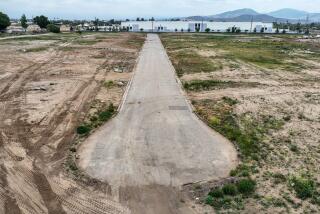Key Ruling Aids Plan for Park Near River
In a victory for urban park advocates, a Los Angeles judge Friday threw out the city’s approval of a controversial industrial project that was slated for land that the governor and others hope to use as part of a new state park.
Judge David Yaffe ruled that Lennar Partners did not conduct an appropriate environmental review, and must do so before the city can legitimately approve building industrial space on the 41-acre site next to the Los Angeles River.
The old Union Pacific switching yard, called the Taylor Yard, has become a focal point for environmental and civil rights advocates hoping to revive the Los Angeles River and create 103 acres of open space for the densely populated neighborhoods around Cypress Park.
“This takes the company back to square one,” said Joel Reynolds, staff attorney for the Natural Resources Defense Council.
Even if Lennar can address the air- and water-quality issues noted by the judge, the company would again have to get city approval, this time in an unwelcoming political climate.
Unlike his predecessor, the new councilman for the area, Ed Reyes, does not back Lennar. The company’s biggest supporter, former Mayor Richard Riordan, is gone. And more than $45 million in state funds has now been allocated for Taylor Yard State Park.
“What this decision does is it gives residents a tremendous new opportunity to shape and define what they want for the neighborhood,” Reyes said. “It’s the opportunity to start all over again.”
With a massive infusion of state bond money last year, the urban parks movement has been gaining momentum, scoring victories for a proposed state park in the Baldwin Hills this month and one near Chinatown in March.
The proposed greenbelt at Taylor Yard would occupy 62 or 103 acres, depending on the Lennar parcel. One widely circulated plan calls for tearing down a 2,000-foot stretch of concrete riverbank to create a meandering side stream, pools and a nature habitat for hikers, bicyclists and equestrians.
Environmentalists hope to use the disputed acreage for soccer and baseball fields, tennis courts and underground parking. The 41 acres would connect the natural parts of the park to the main entry from San Fernando Road.
Lennar hoped to build 650,000 square feet of industrial space, as well as a restaurant, theater and retail complex that the community wanted. Executives at Lennar did not return phone calls seeking comment on their intentions.
Park advocates have been negotiating with the company to buy the option on the land.
Attorneys representing Friends of the Los Angeles River, a local soccer club and other environmental groups filed a lawsuit against Lennar in January, arguing that it needed to conduct a full environmental impact report. Such a review would require the city to assess alternatives for the site, including the park, discussed at public hearings. With the $45 million in state money and few parks in the area, the greenbelt is sure to be a major consideration.
“This decision was not just a technicality,” said Robert Garcia, an attorney for the Center for Law in the Public Interest. “They now have to consider the park alternative. And they have to allow the community full and fair participation in demanding Taylor Yard.”
In his ruling to compel the full environmental review, the judge agreed with the plaintiffs’ contentions that Lennar had not adequately reviewed the project’s impact on local air and water quality and on a river bike path.
Lennar’s attorney said the judge was asking them to do more than was required by the protocol established by the air quality district. “We’re disappointed,” said Steve Weston. “I think we have looked at these issues enough.”
A deputy city attorney echoed the sentiment. “We really feel the city’s decision should have been upheld,” said Terry Kaufman Macias.
Residents who joined a coalition to create the state park rejoiced after the ruling. Guillermo Reyes Jr. said the local park where he played as a child gets so crowded now that his grandchildren play three games of T-ball on a single field.
“When they hit the home run, the ball lands in another game,” he said.
Marcus Gutierrez, 50, said he had to take his sons to Eagle Rock to play baseball when they were young. If Lennar and the city go through the public hearing process, he said, they will learn that the community desperately needs a place for kids to play.
“If they have to go back and address the community, they’ll know exactly what the community wants. They should have done this years ago.”
More to Read
Sign up for Essential California
The most important California stories and recommendations in your inbox every morning.
You may occasionally receive promotional content from the Los Angeles Times.











